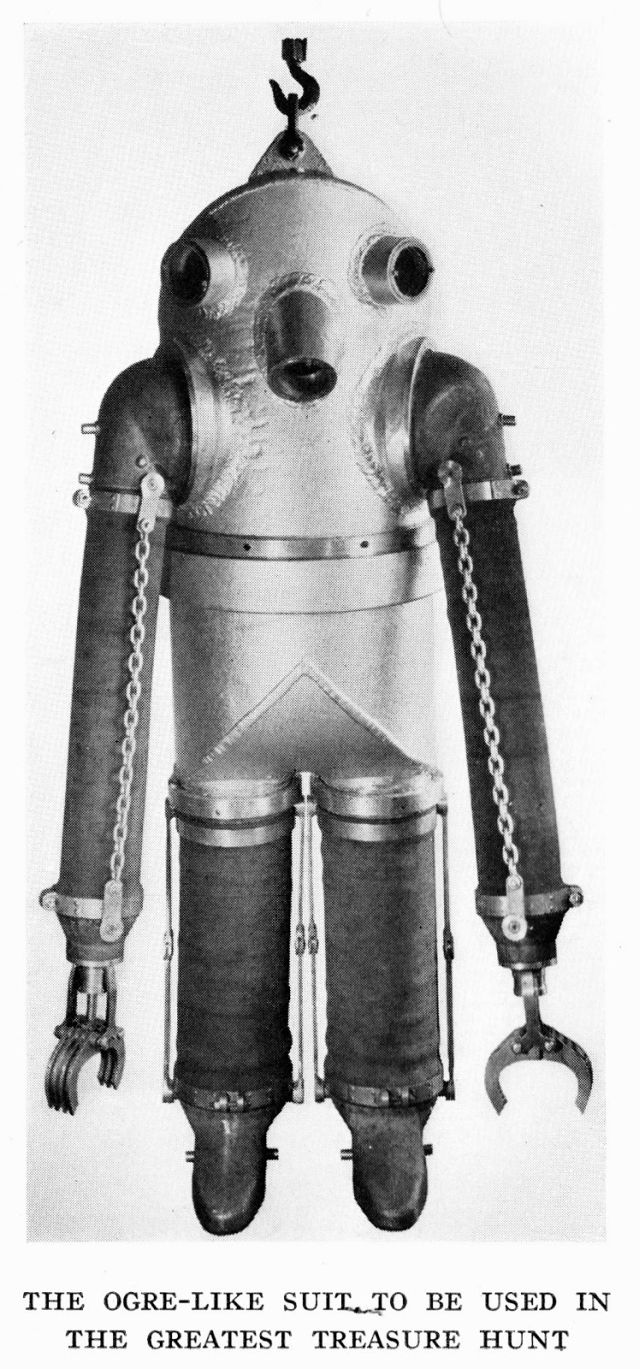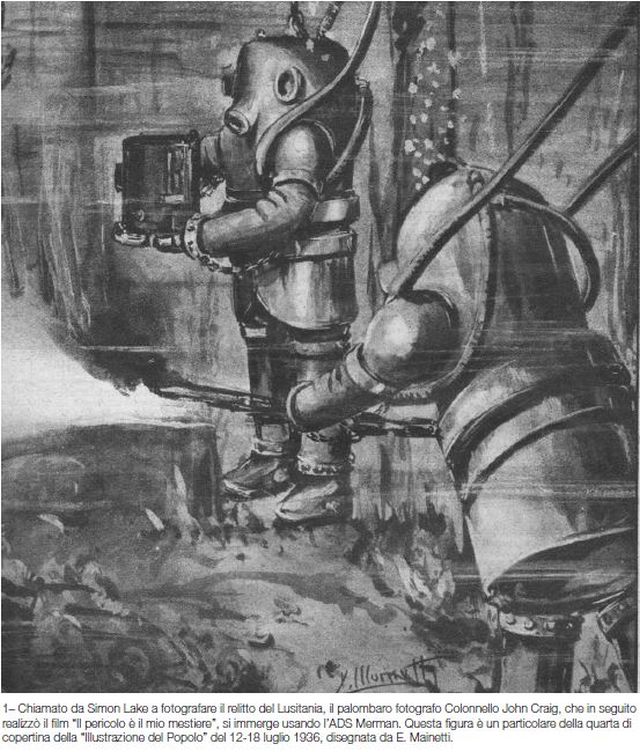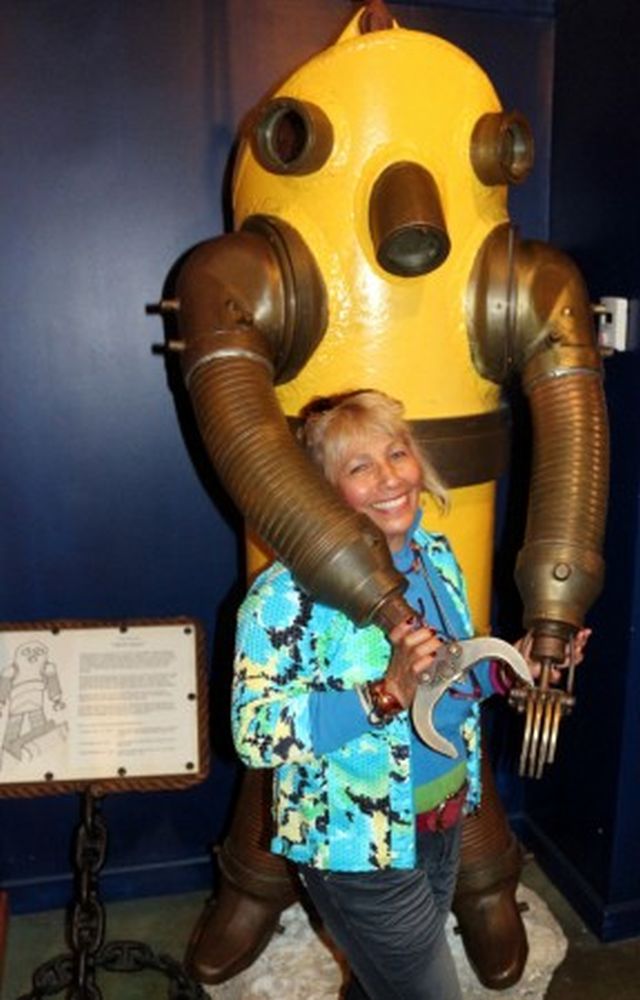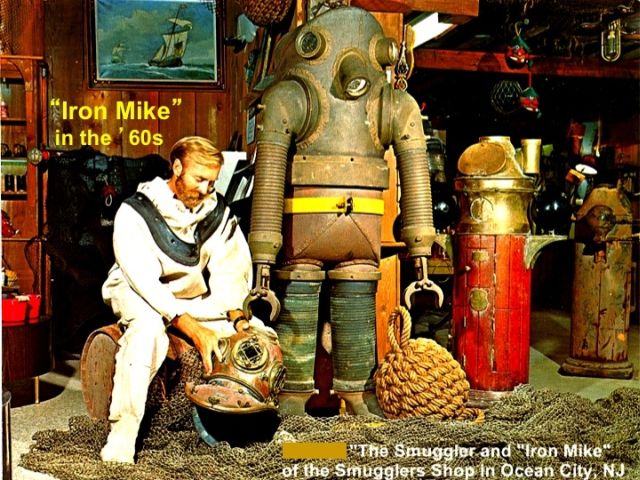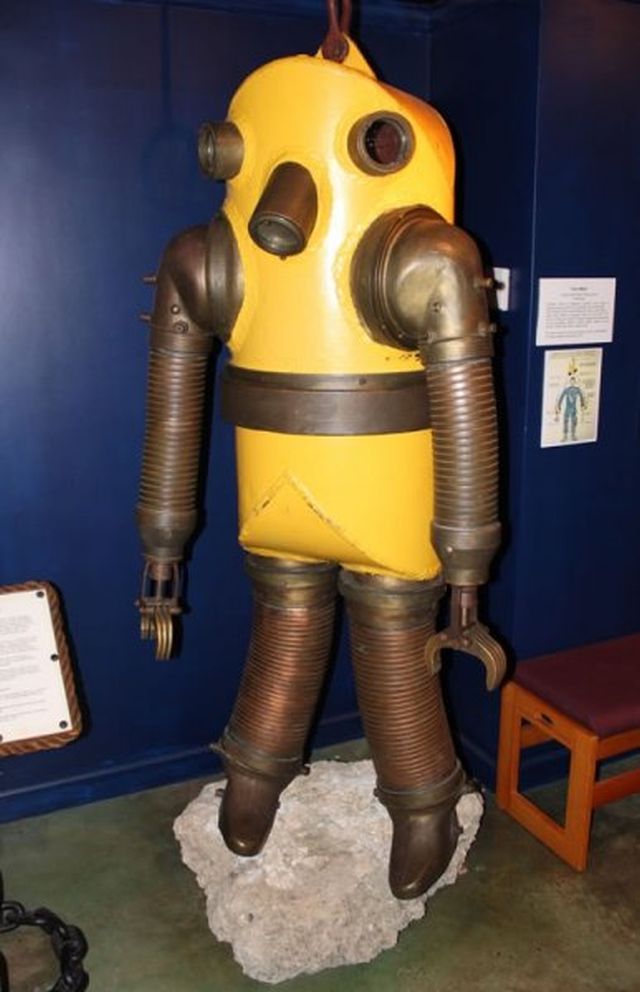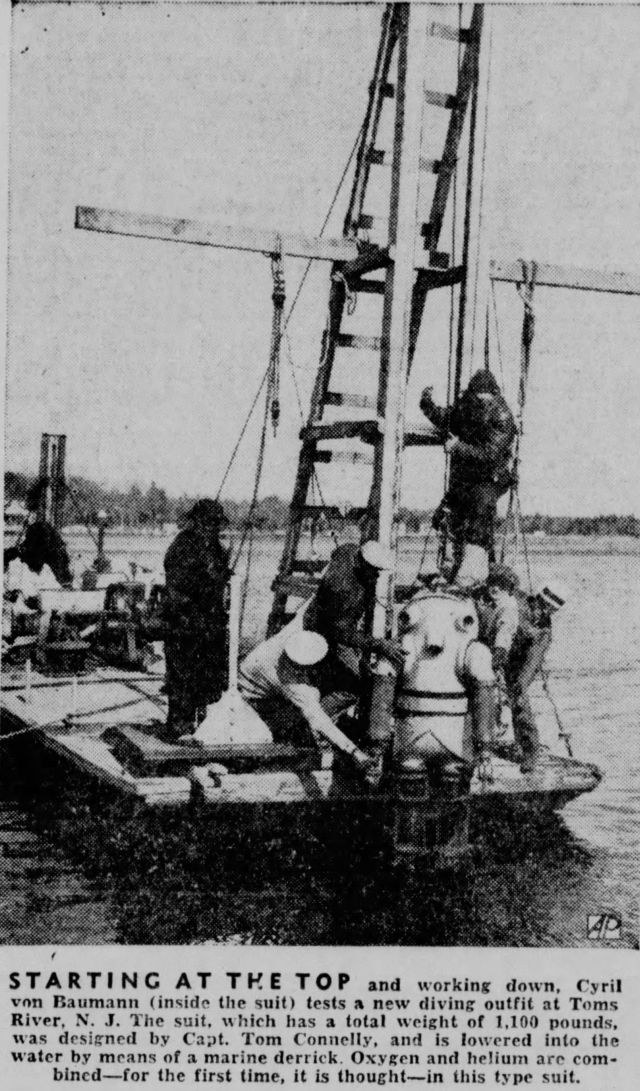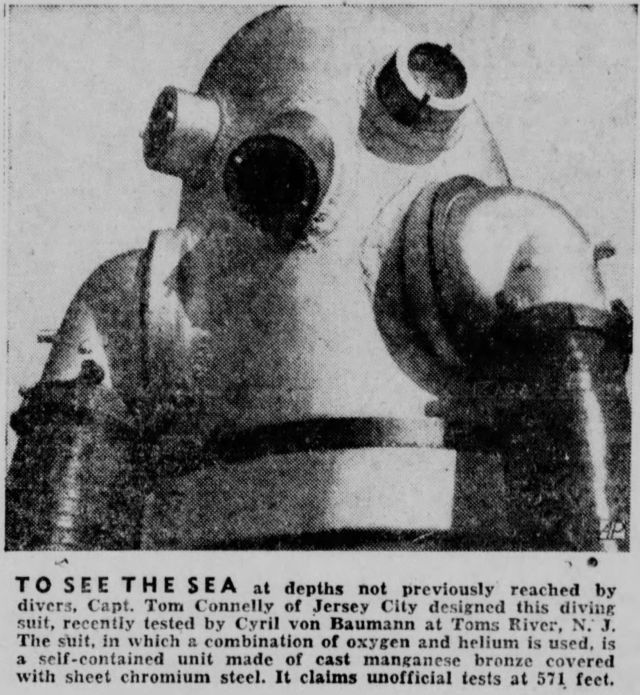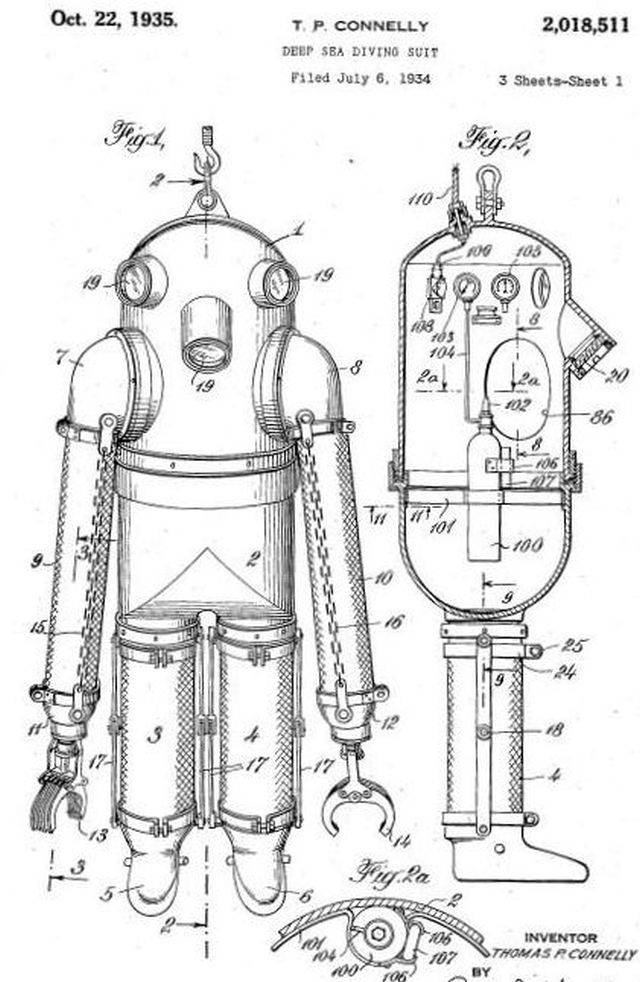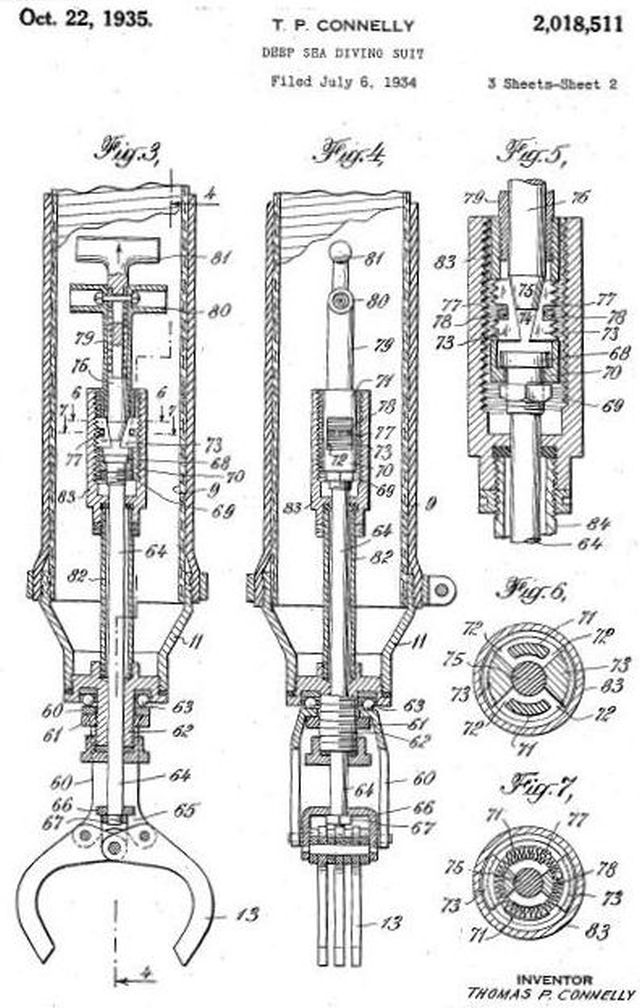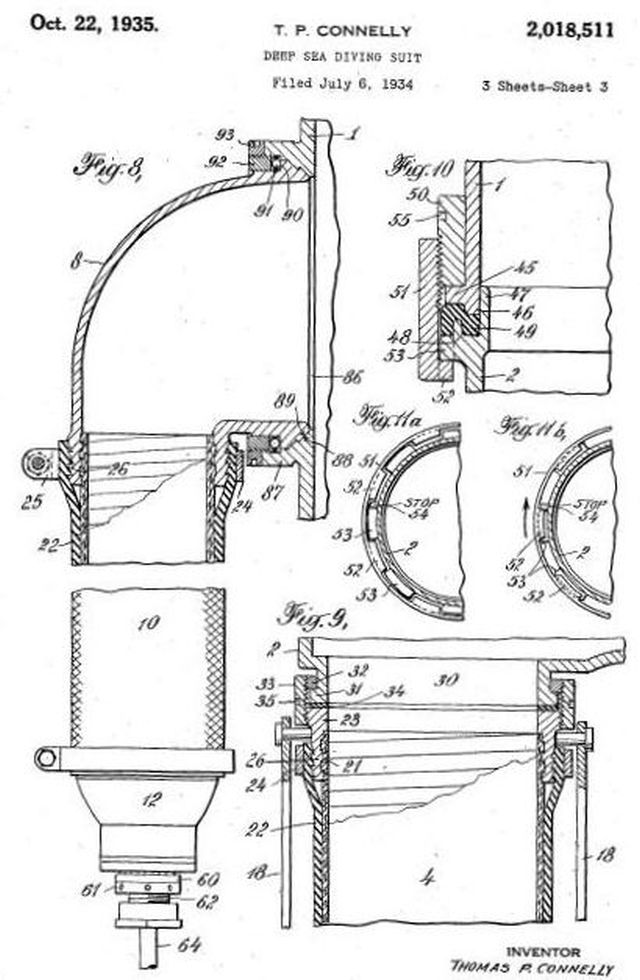1934 – Deep Sea Diving Suit by Thomas Connelly.
Note incorrect depiction of air lines, of which there should be none, as the suit employed a rebreather system.
Source: History of Diving Museum
A pair of powerful lamps attached to the writs of "Iron Mike".
Source: Middletown Times Herald, Mar 28, 1939.
Cyril Von Baumann – Explorer
At Toms River, N.J. – Cyril Von Baumann, explorer and writer, is shown with a new type of diving: suit, which he recently gave a successful tryout. The cylinder he holds supplies the diver with a mixture of helium and oxygen, eliminates the usual air line. The inventor expect to attain depths of 2,000 feet for twelve-hour periods.
Archive: The Seattle Times / Rogers Photo Archive
Time and date:3/26/1939 12:00:00 AM
Patent name: Deep sea diving suit
Publication number US2018511 A
Publication type Grant
Publication date Oct 22, 1935
Filing date Jul 6, 1934
Priority date Jul 6, 1934
Inventors Patrick Connelly Thomas
Original Assignee Empire Marine Salvage & Engine
The diving suit in accordance with the present invention comprises an upper metallic body or helmet portion having arm portions of non collapsible flexible tubing articulated thereto, and a lower. metallic body portion or torso joined to leg portions of non-collapsible flexible tubing terminating in metallic feet. Articulated braces are provided for the leg portions. The arm portions terminate in grappling jaws manipulatable from within the arm portions.
A feature of the invention resides in a novel arrangement for so uniting the helmet and lower body portions in a fluid-tight joint, that the helmet may be removed in a few seconds to permit of access to the diver in the event of an accident. This joint is characterized in the provision of a flanged termination for the helmet on which an externally threaded ring member is rotatably supported. A second ring member threaded to the first is provided with peripherally spaced inwardly projecting lugs adapted, in assembling the helmet and body portions, to pass between spaced outwardly projecting peripherally spaced lugs formed on the body portion, to provide a lap joint between the helmet and body portions. Thereafter the second ring is rotatable to align the lugs of the ring member with those of the body portion thereby to provide locking engagement between the helmet and body portions. The body portion is rabbeted at its upper edge to house a gasket of rubber or the like interposed between the body portion and the helmet. Once the locking engagement is secured, the joint may be tightened to fluid-tight proportions by application of a wrench to screw the first ring member into the second.
A second feature of the invention resides in the novel means for manipulating the grappling jaws from within the arm portions. The manipulation is such that the diver may quickly grapple an object and then lock the jaws in a desired closure to maintain his grasp. This locking engagement is effected by means of a screw-threaded leverage which maybe employed additionally further to tighten the grip of the jaws on the object.
To this end each pair of jaws has linked thereto a rod displaceable within a metallic sleeve of the associated arm portion to close the jaws on the object by means of a grip available within the sleeve to the operator. Rotatably affixed to the displaceable rod, is a resiliently contractible segmented member the segments of which, exteriorly threaded, are expandable by a second 5 grip into threaded engagement with a threaded portion of the metallic sleeve thereby to lock the jaws in a desired closure. The grips may be rotated by the operator to further tighten the jaws upon the object by virtue of the threaded leverage provided between the threadedly engaged segments and sleeve.
Still another feature of the invention consists in the improved means employed for articulating the arm portions to the helmet. The helmet is provided with arm holes comprising a pair of circular, tapered, stepped recesses, each of which cooperates with a beveled, stepped edge of an arm portion to form bearing surfaces. These surfaces are maintained in fluid-tight articular contact by means of a bushing threaded to and surrounding the recess, the bushing exerting pressure against the arm portion through the medium of a ball bearing interposed between the helmet and the arm portion.
The buoyancy of the suit is such that it will normally remain in an upright position. The diver may lean over by throwing his body weight in a desired direction, but as soon as the force thus exerted is removed, the suit will automatically resume an upright attitude. This highly advantageous feature is believed to constitute a radically new departure from the known constructions of metallic diving suits. It results from the fact that the helmet and body portions of the suit comprise an air chamber of considerable buoyancy maintained in a vertical position by the anchoring effect of the relatively heavy leg and feet portions, which, owing to their relatively small cubical content, have, of themselves, little inherent buoyancy.
The suit of the present invention requires no air hose extending to the surface there to be supplied from a pumping system such as is present in the orthodox construction. To eliminate this undesirable element with its accompanying danger of failure in air supply, the suit is equipped with an oxygen tank permitting the diver to remain submerged for approximately four hours. A bottle of caustic soda or other suitable chemical absorbs the carbon dioxide as well as the deleterious gases of exhalation. Gauges are provided as part of the suit equipment for indicating to the diver the pressure in the suit as well as that in the tank. Communication is effected by means of phones or the like connected by a cable to the supply ship.
Connelly's suit is similar to Leavitt's suit.
See other early Underwater Robots here.
